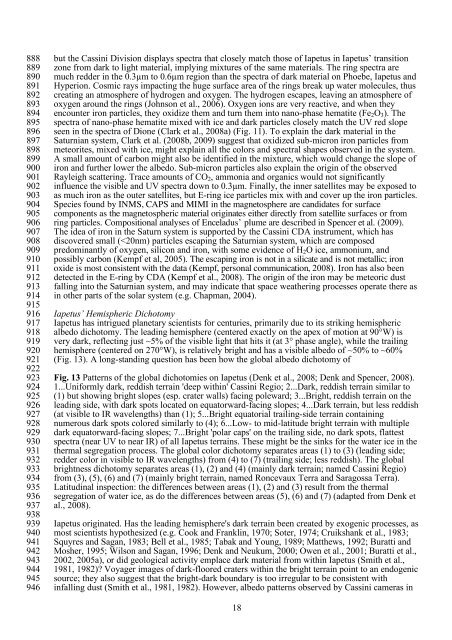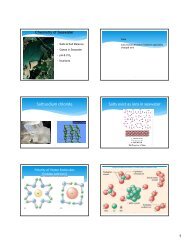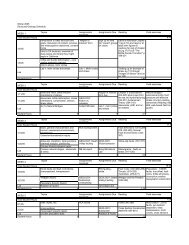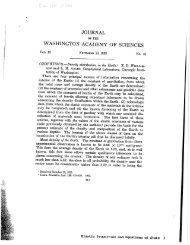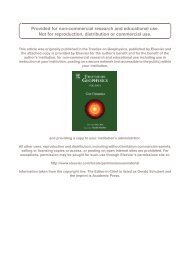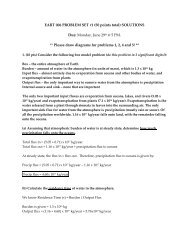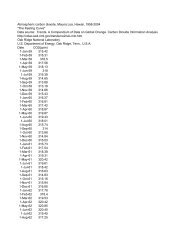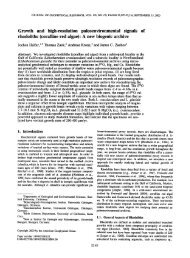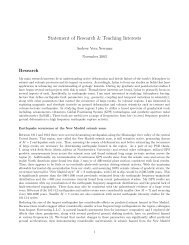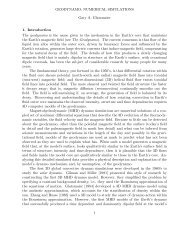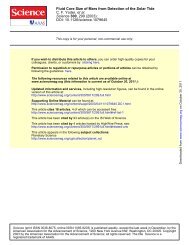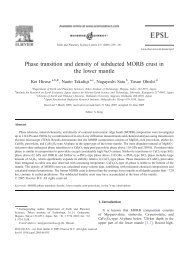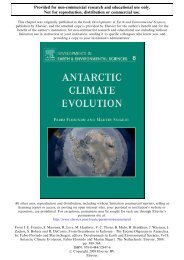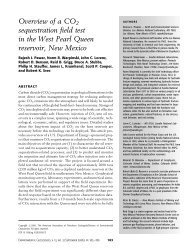Reprint - Earth & Planetary Sciences - University of California, Santa ...
Reprint - Earth & Planetary Sciences - University of California, Santa ...
Reprint - Earth & Planetary Sciences - University of California, Santa ...
Create successful ePaper yourself
Turn your PDF publications into a flip-book with our unique Google optimized e-Paper software.
888 but the Cassini Division displays spectra that closely match those <strong>of</strong> Iapetus in Iapetus’ transition<br />
889 zone from dark to light material, implying mixtures <strong>of</strong> the same materials. The ring spectra are<br />
890 much redder in the 0.3µm to 0.6µm region than the spectra <strong>of</strong> dark material on Phoebe, Iapetus and<br />
891 Hyperion. Cosmic rays impacting the huge surface area <strong>of</strong> the rings break up water molecules, thus<br />
892 creating an atmosphere <strong>of</strong> hydrogen and oxygen. The hydrogen escapes, leaving an atmosphere <strong>of</strong><br />
893 oxygen around the rings (Johnson et al., 2006). Oxygen ions are very reactive, and when they<br />
894<br />
895<br />
encounter iron particles, they oxidize them and turn them into nano-phase hematite (Fe2O3). The<br />
spectra <strong>of</strong> nano-phase hematite mixed with ice and dark particles closely match the UV red slope<br />
896 seen in the spectra <strong>of</strong> Dione (Clark et al., 2008a) (Fig. 11). To explain the dark material in the<br />
897 Saturnian system, Clark et al. (2008b, 2009) suggest that oxidized sub-micron iron particles from<br />
898 meteorites, mixed with ice, might explain all the colors and spectral shapes observed in the system.<br />
899 A small amount <strong>of</strong> carbon might also be identified in the mixture, which would change the slope <strong>of</strong><br />
900 iron and further lower the albedo. Sub-micron particles also explain the origin <strong>of</strong> the observed<br />
901<br />
902<br />
Rayleigh scattering. Trace amounts <strong>of</strong> CO2, ammonia and organics would not significantly<br />
influence the visible and UV spectra down to 0.3µm. Finally, the inner satellites may be exposed to<br />
903 as much iron as the outer satellites, but E-ring ice particles mix with and cover up the iron particles.<br />
904 Species found by INMS, CAPS and MIMI in the magnetosphere are candidates for surface<br />
905 components as the magnetospheric material originates either directly from satellite surfaces or from<br />
906 ring particles. Compositional analyses <strong>of</strong> Enceladus’ plume are described in Spencer et al. (2009).<br />
907 The idea <strong>of</strong> iron in the Saturn system is supported by the Cassini CDA instrument, which has<br />
908<br />
909<br />
910<br />
discovered small (


